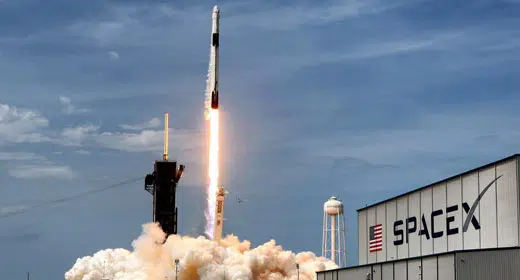by Ry Crist: The billionaire SpaceX CEO is launching satellites into orbit and promising to deliver high-speed broadband internet to as many people as possible.
 When you think of billionaire entrepreneur Elon Musk, chances are high that you think of his electric car company Tesla, his space exploration venture SpaceX, his bid to take control of Twitter or his stint hosting Saturday Night Live. (There’s also his history of stirring up controversy on social media or smoking weed with Joe Rogan.) Maybe you just know him as one of the richest people on Earth, or perhaps as a high-profile example of an unconventional parent.
When you think of billionaire entrepreneur Elon Musk, chances are high that you think of his electric car company Tesla, his space exploration venture SpaceX, his bid to take control of Twitter or his stint hosting Saturday Night Live. (There’s also his history of stirring up controversy on social media or smoking weed with Joe Rogan.) Maybe you just know him as one of the richest people on Earth, or perhaps as a high-profile example of an unconventional parent.
Something you might be less familiar with is Starlink, a venture that aims to sell internet connections to almost anyone on the planet by way of a growing network of private satellites orbiting overhead.
After years of development within SpaceX — and after securing nearly $885.5 million in grant funds from the Federal Communications Commission at the end of 2020 — Starlink picked up the pace in 2021. In January, after three years’ worth of successful launches, the project had surpassed 1,000 satellites delivered into orbit. One year and dozens of successful launches later, Starlink boasts more than 2,000 functional satellites orbiting overhead.
Starlink’s business is accelerating, as well. In February last year, Musk’s company disclosed that Starlink was serving more than 10,000 customers. Now, after expanding preorders to even more potential customers, releasing a second-gen home internet satellite dish and exploring the possibility of providing in-flight Wi-Fi for passenger aircraft, Musk says that Starlink has shipped more than 100,000 satellite internet terminals to customers in 14 countries. That list includes Ukraine, where Musk said in February additional satellite internet terminals were en route amid the Russian invasion (and amid Russian attempts to jam the signal), a move that cost US taxpayers $3 million, per a report from the Washington Post.
We’ll continue to monitor Starlink’s progress in 2022. For now, here’s everything you should know about it.
OK, start at the beginning: What is Starlink, exactly?
Technically a division within SpaceX, Starlink is also the name of the spaceflight company’s growing network — or “constellation” — of orbital satellites. The development of that network began in 2015, with the first prototype satellites launched into orbit in 2018.
In the years since, SpaceX has deployed thousands of Starlink satellites into the constellation across dozens of successful launches, the most recent of which took place on April 21 and delivered another 53 satellites into low-earth orbit. That brings the total number of satellites launched to 2,388, more than 2,000 of which appear to be operational parts of the constellation.
And those satellites can connect my home to the internet?
That’s the idea, yes.
Just like existing providers of satellite internet like HughesNet or Viasat, Starlink wants to sell internet access — particularly to people in rural areas and other parts of the world who don’t already have access to high-speed broadband.

“Starlink is ideally suited for areas of the globe where connectivity has typically been a challenge,” the Starlink website reads. “Unbounded by traditional ground infrastructure, Starlink can deliver high-speed broadband internet to locations where access has been unreliable or completely unavailable.”
All you need to do to make the connection is set up a small satellite dish at your home to receive the signal and pass the bandwidth on to your router. The company offers a number of mounting options for rooftops, yards and the exterior of your home. There’s even a Starlink app for Android and iOS that uses augmented reality to help customers pick the best location and position for their receivers.
Starlink’s service is only available in select regions in the US, Canada and abroad at this point, but the service now boasts more than 100,000 satellite terminals shipped to customers, and the coverage map will continue to grow as more satellites make their way into the constellation. Eventually, Starlink hopes to blanket the entire planet in a usable, high-speed Wi-Fi signal.

How fast is Starlink’s internet service?
According to the internet speed-tracking site Ookla, which analyzed satellite internet performance during the fourth quarter of 2021, Starlink offered download speeds exceeding 100Mbps in 15 different countries last year, with average speeds in Q4 that were higher than Q3. In the US, Starlink offered average download speeds of about 105Mbps and average upload speeds of about 12Mbps, which is about five or six times better than the averages for satellite rivals Viasat and HughesNet, and just shy of the overall average for the entire fixed wireless internet category, which includes satellite and other forms of delivering connectivity to peoples’ homes without ground-laid infrastructure.
“Users can expect to see data speeds vary from 50 to 150 megabits per second and latency from 20 to 40 milliseconds in most locations over the next several months,” Starlink’s website says, while also warning of brief periods of no connectivity at all. “As we launch more satellites, install more ground stations and improve our networking software, data speed, latency and uptime will improve dramatically.”
To that end, Musk tweeted in February of last year that he expected the service to double its top speeds to 300Mbps by the end of 2021. Now, in 2022, claims like those are difficult to evaluate, as speeds will vary depending on time and location.
Last year, CNET’s John Kim signed up for the service at his home in California and recently began testing it out at a variety of locations. At home, he averaged download speeds around 78Mbps, and latency around 36ms.
How much does Starlink cost?
Starlink is now accepting orders on a first-come, first-served basis, so you’ll need to request service, put down a $99 deposit, and then wait your way through the backlog. During its beta in 2021, Starlink said that some preorders could take as long as six months to fulfill — in some regions, Starlink now says that new orders may not be fulfilled until 2023 or later.
The cost of the service was initially billed at $99 per month, plus taxes and fees, plus an initial payment of $499 for the mountable satellite dish and router that you’ll need to install at home. In March, and in spite of earlier predictions from SpaceX executives that the hardware costs would come down over time, SpaceX raised those prices to $110 per month and $599 upfront for the hardware.
$110 per month is a lot for an internet connection, especially one that isn’t nearly as fast as a fiber connection, but Musk is betting that the cost will be worth it for people who have thus far lived without access to a reliably fast connection at all.
In April of last year, SpaceX President Gwynne Shotwell said that Starlink wanted to keep pricing as simple and transparent as possible, and had no plans to introduce service tiers into the mix. However, that approach seems to be changing in 2022 with the introduction of a new premium tier with a scan array that’s twice as big as the standard plan and with download speeds ranging from 150-500Mbps. That tier costs $500 per month, plus an initial payment of $2,500 for the equipment. Starlink is taking orders for that tier now, and plans to launch the service later in 2022.
Where is Starlink available?

Despite promising to blanket the entire globe in coverage by this fall, Starlink service is currently limited to select regions in select countries. Still, the coverage map will grow considerably as more satellites join the constellation.
Per Musk, the list of countries currently serviced by the growing network of low-earth orbit satellites includes the US, Canada, the UK, France, Germany, Austria, the Netherlands, Ireland, Belgium, Switzerland, Denmark, Portugal, Australia and New Zealand. Starlink’s preorder agreement includes options for requesting service in other countries, too, including Italy, Poland, Spain and Chile.
There’s still a ways to go — Starlink will likely need at least 10,000 satellites in orbit before it can claim to offer full service to a majority of the globe (and SpaceX has shown signs that it wants as many as 42,000 satellites in the constellation). Right now, it’s only about 20% of the way there, at best, with coverage focused on regions sitting between 45 and 53 degrees north latitude.
Still, Musk has been bullish about the Starlink timeline. During an interview at 2021’s Mobile World Congress, Musk said that Starlink would hit worldwide availability except at the North and South Poles starting in August. Earlier in June, Shotwell expressed a similar sentiment, and said that Starlink would reach global serviceability sometime this fall.
“We’ve successfully deployed 1,800 or so satellites, and once all those satellites reach their operational orbit we will have continuous global coverage so that should be like [the] September time frame,” she said.
In September, a Twitter user asked Musk when Starlink would finish its beta phase. “Next month,” Musk replied.
According to the FCC, which recently added Starlink to its database of broadband providers, the service was available to 0.08% of Americans as of December 2020, when Starlink was just launching its beta. At that point, 100% of customers had access to max download speeds of 100Mbps and upload speeds of up to 10Mbps. Future FCC releases will give us a good look at how much the service grew during a busy 2021 — we’ll update this post when those releases arrive in 2022.
Why satellites, anyway? Isn’t fiber faster?
Fiber, or internet delivered via ground-laid fiber-optic cable, offers upload and download speeds that are indeed much faster than satellite internet — but, as companies like Google will tell you, there’s nothing fast about deploying the infrastructure necessary to get fiber to people’s homes. That’s not to say that there’s anything simple about shooting satellites into space, but with fewer sharp-elbowed competitors — and with a lot less red tape to cut through — there’s every reason to believe that services like Starlink will reach the bulk of underserved communities long before fiber ever will. Recent FCC filings also suggest that Starlink could ultimately double as a dedicated phone service, too.
And don’t forget that this is Elon Musk we’re talking about. SpaceX is the only company on the planet with a landable, reusable rocket capable of delivering payload after payload into orbit. That’s a mighty advantage in the commercial space race. On top of that, Musk said in 2018 that Starlink will help provide SpaceX with revenue needed to fund the company’s long-held ambition to establish a base on Mars.
If that day arrives, it’s also likely that SpaceX will try to establish a satellite constellation on the red planet, too. That means that Starlink customers are potentially doubling as guinea pigs for the Martian wireless networks of the future.
“If you send a million people to Mars, you better provide some way for them to communicate,” Shotwell said in 2016, speaking about the company’s long-term vision for Starlink. “I don’t think the people who go to Mars are going to be satisfied with some terrible, old-fashioned radios. They’ll want their iPhones or Androids on Mars.”
As CNET’s Jesse Orral noted in a recent video about Starlink, you’ll even find hints of Musk’s plans for Mars in the Starlink terms of service, which at one point reads:
“For services provided on Mars, or in transit to Mars via Starship or other colonization spacecraft, the parties recognize Mars as a free planet and that no Earth-based government has authority or sovereignty over Martian activities.”
Still, with top speeds currently pegged at 150Mbps, Starlink’s satellite internet won’t be anywhere near the gigabit fiber speeds people on Earth are used to anytime soon — and that’s due to the sheer distance each transmission needs to travel on its round trip from your home to the stratosphere. It’s a factor that also jacks up latency, which is why you’ll often notice awkward lulls in the conversation if you’re talking to someone over a satellite connection.
That said, Starlink promises to improve upon existing expectations for satellite connections by placing satellites into orbit at lower altitudes than before — 60 times closer to the Earth’s surface than traditional satellites, per the company’s claims. This low-earth orbit approach means that there’s less distance for those Starlink signals to travel — and thus, less latency. We’ll let you know how those claims hold up once we’re able to test the Starlink network out for ourselves.

Is Starlink reliable?
Early reports from outlets like Fast Company and CNBC seem to indicate that Starlink’s first customers are satisfied with the service, though the company warns of “brief periods of no connectivity at all”during beta.
The website DownDetector.com, which tracks service outages, lists four disruptions to Starlink in 2021, one each in January, February, and April, with the most recent outage occurring on May 6. For comparison, DownDetector lists no major outages in 2021 for HughesNet, and one in February for ViaSat.
Starlink users spanning from Arizona to Alberta, Canada noted the May outage on Reddit — for most, service seemed to resume within a few hours.
What about bad weather and other obstructions?
That’s definitely one of the downsides to satellite internet. Per Starlink’s FAQ, the receiver is capable of melting snow that lands on it, but it can’t do anything about surrounding snow build-up and other obstructions that might block its line of sight to the satellite.
“We recommend installing Starlink in a location that avoids snow build-up and other obstructions from blocking the field of view,” the FAQ reads. “Heavy rain or wind can also affect your satellite internet connection, potentially leading to slower speeds or a rare outage.”
Are there other issues with Starlink’s satellites?
There’s plenty of concern about the proliferation of privately owned satellites in space, and controversy in astronomical circles about the impact low-orbiting satellites have on the night sky itself.
In 2019, shortly after the deployment of Starlink’s first broadband satellites, the International Astronomical Union released an alarm-sounding statement warning of unforeseen consequences for stargazing and for the protection of nocturnal wildlife.
“We do not yet understand the impact of thousands of these visible satellites scattered across the night sky and despite their good intentions, these satellite constellations may threaten both,” the statement reads.
Since then, Starlink has begun testing a variety of new designs intended to reduce the brightness and visibility of its satellites. At the start of 2020, the company tested a “DarkSat” satellite that included a special, nonreflective coating. Later, in June of 2020, the company launched a “VisorSat” satellite that features a special sunshade visor. In August, Starlink launched another batch of satellites — this time, all of them were equipped with visors.
“We want to make sure we do the right thing to make sure little kids can look through their telescope,” Shotwell said. “It’s cool for them to see a Starlink. But they should be looking at Saturn, at the moon … and not want to be interrupted.”
“The Starlink teams have worked closely with leading astronomers around the world to better understand the specifics of their observations and engineering changes we can make to reduce satellite brightness,” the company website reads.
OK. Where can I learn more about Starlink?
We’ll continue to cover Starlink’s progress from a variety of angles here on CNET, so stay tuned. You should also be sure to read Eric Mack’s excellent profile of Starlink — among other issues, it takes a close look at the project’s goals and challenges, as well as the implications for underserved internet consumers, and for astronomers concerned with light pollution obstructing views in the night sky.
Beyond that, we expect to continue testing Starlink’s network for ourselves throughout this year. When we know more about how the satellite service stacks up as an internet provider, we’ll tell you all about it.
SpaceX Starlink Internet Has 150,000 Daily Users in Ukraine
Elon Musk’s satellite internet service is helping the war-torn Eastern European country stay connected.

Sean Keane
SpaceX’s Starlink satellite internet has been vital for Ukrainians who’ve remained in the Eastern European country during the Russian invasion, a top Ukrainian official said in a tweet. The service from Elon Musk’s rocket company has roughly 150,000 daily users in Ukraine, according to vice prime minister Mykhailo Fedorov.
“This is crucial support for Ukraine’s infrastructure and restoring the destroyed territories,” Fedorov, who also serves as the nation’s minister of digital transformation, wrote. “Ukraine will stay connected no matter what.”
Rough data on Starlink’s usage: around 150K active users per day. This is crucial support for Ukraine’s infrastructure and restoring the destroyed territories. Ukraine will stay connected no matter what. pic.twitter.com/XWjyxPQJyX
— Mykhailo Fedorov (@FedorovMykhailo) May 2, 2022
Starlink is SpaceX’s network of private, orbital satellites, aimed at providing an internet connection to anyone on the planet. Prototype satellites were launched into orbit in 2018 and the company has since deployed nearly 2,000 more across dozens of launches.
Days after the invasion began in late February, Starlink terminals were sent to Ukraine in response to a request from Fedorov — Musk confirmed that the network was live in Ukraine and promised that more terminals would be sent to the country. He also warned people using the terminals to be cautious due to the likelihood that they’d be targeted by Russian troops in an attempt to disrupt communications.
The US government may have subsidized the operation to send Starlink terminals and service to Ukraine, The Washington Post reported in April.
SpaceX didn’t immediately respond to a request for comment about Fedorov’s tweet.

New Starlink Feature Lets You Travel With Your Internet Service for an Extra $25
Elon Musk’s internet provider will let customers temporarily move service without changing their address.

Starlink, the satellite internet provider from SpaceX, now lets customers move their internet service around the country for an additional $25 a month. Portability mode “enables users to temporarily move their Starlink to new locations in order to receive service anywhere within the same continent Starlink provides active coverage,” the company said on its website.
Starlink warns that customers operating from their service address will receive priority, which means customers using portability mode may experience slower than normal speeds or interrupted service away from their service address. Portability mode doesn’t let customers use the internet while they’re in motion, such as while driving down the road.
While portability mode allows users to move around the continent, if they operate their Starlink internet service for more than two months in a foreign country, they’ll need to change service addresses. People who move permanently will still need to change their service address, too. Service is also limited to areas where Starlink’s service is active.
The $25 charge for portabiity mode is on top of the monthly service fee, which recently increased from $99 to $110. New customers will also need to pay a onetime equipment fee of $599.












































